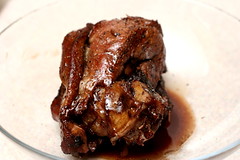| Beef top round with parsnips, carrots, onion, gold beets & rutabaga (Photo credit: Wikipedia) |
Regardless of what you include in your pot, one thing is certain. Because braising involves cooking in liquid for longer periods of time, your house is sure to be filled with the most delightful aromas, and your meat will be fork-tender… just like grandma’s. Not only that, but studies have shown meats cooked at higher heat, such as fried or grilled, are more likely to contain carcinogens. Braising is a slow-cooking method at lower heat, so it brings out the flavor and nutrients of the meat in a healthier manner.
In culinary arts school, professional chefs learn to start the braising process by searing the meat in hot oil. The reason for this is twofold. First, searing seals the meat (trapping the juices inside) so the meat doesn't become dry when cooked. Second, searing your meat before braising brings out a lot of flavor. The caramelization of the meat on the bottom of the pan gives an extra layer of rich essence to the recipe.
Once the meat has seared and is browned on all sides, remove it from the pan. Create a bed of chopped vegetables (called a mirepoix) on the bottom of the pot. In culinary school, professionals are taught to pair the meat with the flavors of the vegetables. For beef or lamb, you might select carrots, onions and celery for your veggie mix. Allow the vegetables to sweat (cook just until they begin to produce liquid) then add your meat and liquid.
| Braised venison shank (Photo credit: izik) |
In the Los Angeles or Hollywood area, you may be more likely to find lamb shanks braised with rosemary, tomatoes, garlic, onion, chicken stock and red wine. Culinary arts school instructors usually tell would-be chefs to pick up on local flavors whenever possible to bring authenticity to their creations.
Once your favorite seasonings and liquids are in place, reduce the heat to a low setting for stovetop cooking or transfer your pot to the oven and bake at approximately 300 degrees. (Be sure you have an ovenproof pot.) Cook for about 3 hours on the stovetop or 2.5 hours in a 350-degree oven. Plate up your meal and serve with some of the delicious sauce left in the pot! It's a meal everybody will love - and it's really pretty darn easy.



No comments:
Post a Comment
We welcome comments and suggestions!